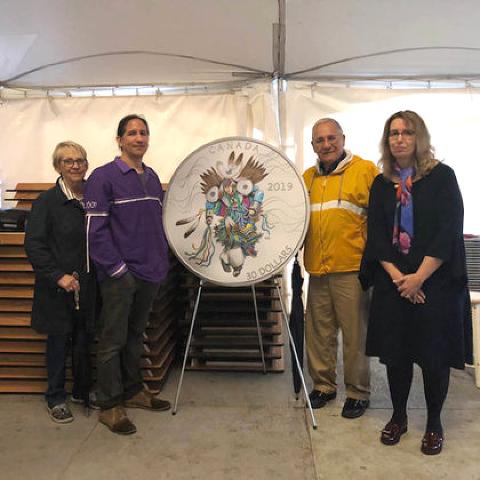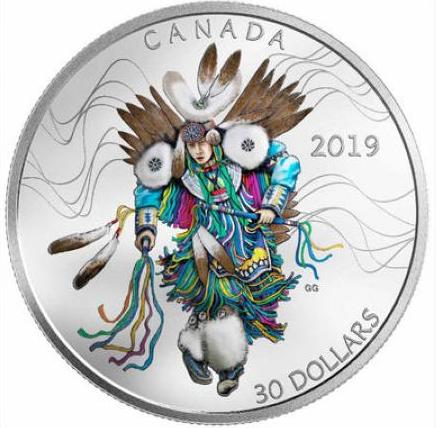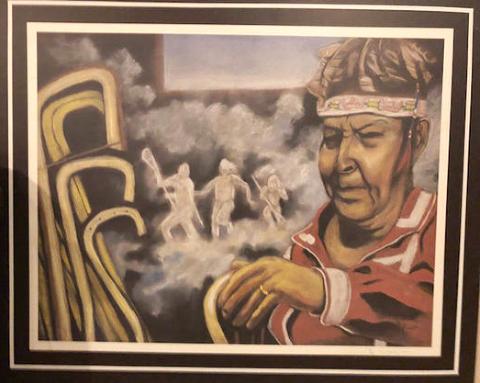 |
Canku Ota
|
 |
|
(Many Paths)
|
||
|
An Online Newsletter
Celebrating Native America
|
||
|
October 2018 - Volume
16 Number 10
|
||
|
|
||
|
Kanienkehá:ka
Artist Garrison Garrow's Royal Canadian Mint Fancy Dance Coin Unveiled
|
||
|
by Kaniehtonkie - Indian
Time
|
||
Garrison Garrow, Kanienkehá:ka artist and designer of several collectable mint coins, unveiled his latest 'Fancy Dance' just before the grand entrance to the First Peoples' House 17th Annual Powwow at McGill University, Montreal, QC. The Fancy Dance coin is meticulously designed reflecting not only the pomp and pageantry of the fancy dance, but more importantly, the pride and cultural heritage of contemporary Indigenous people. Rarely seen colors on the coin portray the fancy dancer in his transformative passage from powwow dancer to an artist totally engaged in movement, ritual and heritage; reflecting a deep sense of movement and heart pounding rhythm found only at powwows. As with many fancy dancers, they mesh their own cultural traditions with borrowed traditions; hence the, 'Thunderbird of the Plains peoples to the Iroquois design on the dancer's apron.' The fancy dance is said to originate from the Ponca Nation in the midwestern United States and was later popularized at wild west shows. It is considered to be a relatively new style of dance by integrating different types of western and midwestern dance into it. Male fancy dancers are known to be athletic and have a great sense of showmanship along with style developing their own dance routine. Garrow stated, "It was a difficult challenge to do this design because it is a Fancy Dance and there is a lot of energy in that dance and there is a lot of power. I wanted to try and capture some of that in a static image. I hope that I did that."
Mark Miller, a Kanien'kéha speaking Member of Parliament for Ville-Marie-Le Sud-Ouest-Île-des-Sœurs, praised the coin for its craftsmanship and symbolism. "Federal governments banned this type of regalia that people wear so proudly today. It's being brought back from a very dark place," said Miller. "Our governments, our people, were complicit in putting it down. Today is but a symbolic gesture – but a very important one – to keep shining the light on the beauty in the traditions that keep the culture, the language and the lives of people vibrant." After the unveiling of the Royal Canadian Mint coin, powwow singers began to play in the big tent with torrents of rain outside, "Welcome to McGill University under the rain," said Louis Arseneault, Vice-Principal Communications and External Relations. Arseneault added, "This land has long served as the site of meeting and exchange amongst Indigenous people... We acknowledge the diverse Indigenous peoples whose footsteps have marked this territory on which peoples of the world now gather." "The Royal Canadian Mint prides itself on telling the fascinating story of Canada through coins and celebrating First Nations, Inuit and Métis cultures is fundamental to achieving that goal," said Jennifer Camelon, Interim President and CEO of the Royal Canadian Mint. "Our beautifully coloured coin celebrating the dazzling art of the Fancy Dance is yet another opportunity for Indigenous artists from across Canada to share their talent, traditions and cultures." The Fancy Dance coin has a face value of $30 is 50 millimeters across and is a collector's edition, with a mintage limited to 3,500. It's one of several coins released by the Mint over the years to honor First Nations, Métis and Inuit.
This isn't the first coin designed by Garrow. He also designed a medal that was gifted to Pope Benedict XVI in Rome, Italy during the Canonization of Kateri Tekakwitha in 2012, "When Garrison agreed to take on this project he wanted to portray Kateri in a different light. He didn't draw her wearing a headband as so many others have, nor a leather dress. On her dress, he drew designs on her collar showing the Sky Domes and Two Row Wampum. Underneath her collar on her blouse he showed her holiness with prayer beads. He showed her beauty as she looked face front instead of the raised look as others showed. On the back of the medal was displayed her turtle clan (Iakoniahton), as well as the flowing of green plants growing upward similar to the look of a Tree of Peace." Garrow's artistry is also demonstrated by the Canadian Lacrosse Federation's use of his painting, "Wes Patterson at Work" to honor the game of lacrosse. |
|||||
|
|
|
|
||
|
|
||
| Canku Ota is a free Newsletter celebrating Native America, its traditions and accomplishments . We do not provide subscriber or visitor names to anyone. Some articles presented in Canku Ota may contain copyright material. We have received appropriate permissions for republishing any articles. Material appearing here is distributed without profit or monetary gain to those who have expressed an interest. This is in accordance with Title 17 U.S.C. Section 107. | ||
|
Canku Ota is a copyright ©
2000 - 2018 of Vicki Williams Barry and Paul Barry.
|
||
 |
 |
|
|
The "Canku
Ota - A Newsletter Celebrating Native America" web site and
its design is the
|
||
|
Copyright ©
1999 - 2018 of Paul C. Barry.
|
||
|
All Rights Reserved.
|
||


